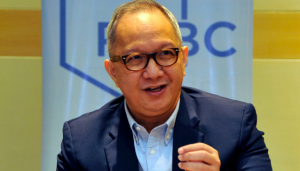
The banking industry has started looking at Mindanao as an emerging growth area considering that peace has started to become stable.
In a press conference here Monday afternoon, Eugene S. Acevedo, president of the Rizal Commercial Banking Corp., said the biggest obstacle to Mindanao growth in the past, the peace and order situation, has become a “non issue,” alluding to the peace agreement that the government and the Moro Islamic Liberation Front have forged.
Unfortunately, Acevedo, who was born in Bislig City in Surigao del Sur, lamented that in the past, banks were not “deliberate strategy to invest and in lending in Mindanao.” “But I think (the failure to come up with a concrete program in Mindanao) has changed,” he said.
Banks, he said, have taken advantage of the programs of the government in Mindanao, particularly the much-touted “Build, Build, Build” program which provides key infrastructure facilities to Mindanao areas that used to be neglected.
One major indication of the growth in Mindanao at present is the growth both of consumer as well as small and medium enterprise loan. In Acevedo’s bank, although the value of these Mindanao loans is still “small” at P6 billion compared with the rest of its loan portfolio, these segments have been “growing fast.”
These portfolios, which the bank’s subsidiary, the Rizal Microbank, is servicing, went up by 27%. “I want it to grow faster,” he said.
Based on reports, the bank’s loan portfolio in 2018 was at P398 billion.
Another indicator, he said is the auto loan, or loan to those who want to buy cars. In the Central Mindanao area, the growth is very high. “One of our successful divisions in auto loans is in Central Mindanao,” he said, although he could provide the value for the loan.
“When people borrowing for cars and they are able to pay their loans, that is a good indicator of the strength of the underlying economy (of the place),” he added.
Among the strategies that the bank is looking at in growing its portfolio in Mindanao is in participating in the agri-value chain order of the Bangko Sentral ng Pilipinas (BSP), considering that agriculture is a major backbone of the island’s economy.
In October 2016, the BSP issued an order to financial institutions like banks to participate in financing agri-value chain programs.
In that order, the BSP said that financial institutions that will join the program must also “to put in place a disaster contingency mechanism requiring the adoption of risk mitigants to minimize losses and provide relief to a borrower to facilitate recovery.”
Acevedo, who got his Physics degree at the University of San Carlos in Cebu City but became a banker after finishing his graduate studies at the Asian Institute of Management, said that he hopes that participating in the agri-value chain program will serve as the banks’ way of complying with the Agri-Agra Reform Credit Act which mandates them to set aside about 20% of their loan portfolio to agriculture.
There have been complaints in the agricultural sector that the law has not been complied with, but Mr. Acevedo said from what he gathered among banks, “there has not been enough capacity out there to meet the agra (law) requirements of the banks.”
He said he has been discussing with the banking industry, particularly the Bankers Association of the Philippines where he serves as among the member of its board of directors, to request the BSP to allow them to fund any project related to agriculture, like farm-to-market roads, as their way of complying with the law.
“I hope that there might an alternative compliance (mechanism to the law),” he said, pointing out that the agri-value chain will help the agricultural sector to grow, the very goal of the law.
The problem, he said, of lending to agriculture is the risk associated with it. An example is when a crop is hit with a typhoon and the farmer does not have a crop insurance, so the loan and the income of the farmer disappear.
Although his bank is not expanding presence through setting up of branches, as it has 58 branches in Mindanao out of the 507 branches nationwide, it will expand through presence of marketing human resources to cater to the Mindanao growth. The number of branches that it has in Mindanao also includes that of its thrift bank.
At present, he said, the bank has dedicated a unit for Mindanao alone, unlike in the past when it was lumped with the Visayas.



